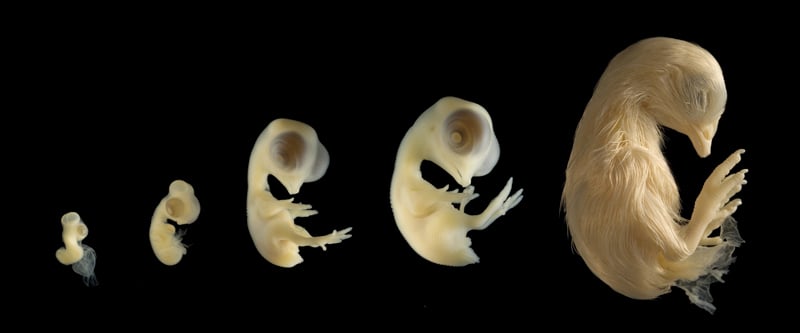A group of Japanese school students have completed an experiment that could be straight out of a futuristic sci-fi movie. The miraculous technique allows a baby chick to grow inside an egg without its shell, therefore allowing a live insight into the embryonic development process.
How did they do it?
First, the students crack a store-bought hen’s egg into a handmade incubation vessel. It’s a plastic cup with cling wrap stretched loosely over the top in a bowl shape. Next, they pour a special growth-supporting solution into both the suspended plastic and the bottom of the cup.
Once the egg is cracked, the students artificially fertilize it, before covering it over with another piece of plastic. To allow oxygen in, the students punch ventilation holes in the top layer of plastic.

Next the students place the vessel into an incubator. They pull it out each day to observe and film the development of the embryo.
By day 3, a beating heart and blood vessels are visible.

By day 5, as seen in the image above, the blastoderm expands considerably to form an embryo. A body and eye ball can be made, surrounding the tiny beating heart.
As the days tick by, the bone structure develops before your eyes. Wings and a beak appear. By day 21, a fully grown chick with feathers has grown inside the plastic vessel. And finally, the clip finishes with an adorable baby chicken running across the laboratory floor.
Watch the fascinating transformation for yourself below:
https://youtu.be/c97zvKWDMfA
The Discovery of the Method
The success of the experiment performed by the students is incredibly impressive. However, it’s not the first time that the technique has been published.
In 1993, Doctor Cynthia Fisher described a similar method in a US biology textbook.
It was next published by researchers Yutaka Tahara and Katsuya Obara in their 2014 study, “A Novel Shell-less Culture System for Chick Embryos Using a Plastic Film as Culture Vessels.” However, the paper explains that the method only obtains an expected 70% hatch rate. So the fact that the students succeeded and caught the entire process on camera is still impressive.

Why is it important?
Watching a baby chicken develop in real time is truly fascinating, but that’s only one benefit of this experiment. The technique is a new tool for use in the preservation of rare birds. It can be used to save eggs that have been broken or are at risk of breaking.
Furthermore, the shell-less egg also allows scientists insight into the growth process of baby birds, something they have been trying to access for years. With the new ability to monitor egg development, they’re also able to study new regenerative medicine techniques.
That’s one small step for the baby chicken, and one giant leap for mankind.

